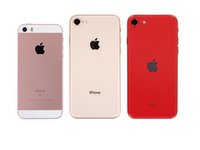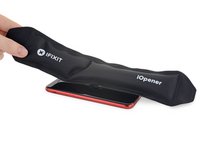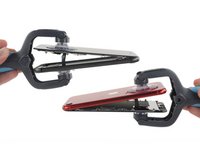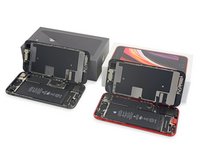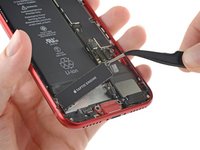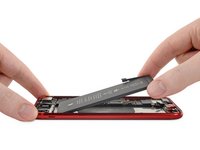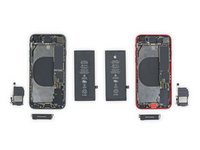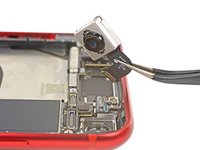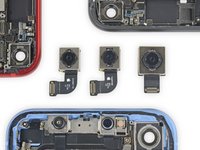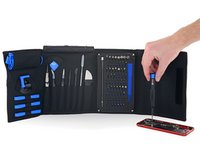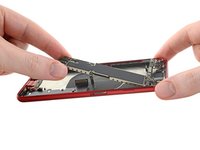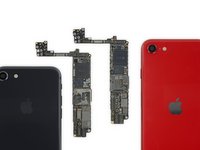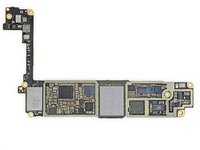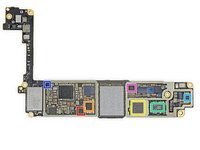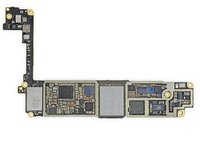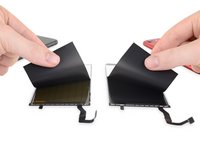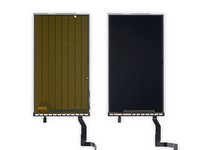Introduction
Second Edition? Smallish Edition? Stimulus Edition? We’re not sure what “SE” stands for this time, but it wouldn’t be an iPhone teardown without a little mystery. And this 2020 iPhone SE is certainly $400 worth of smartphone conundrum—delightfully old-school on the outside, and purportedly pretty modern on the inside. Fortunately our money is already spent, so you get to follow along for free. Let’s tear down Apple’s … newest … iPhone.
Want more free stuff? Check out our iPhone SE teardown wallpapers.
Need even more teardowns in your life? Of course you do! Follow us on Instagram, Twitter, and Facebook to get your teardowns and tech news before all your friends. For iFixit delivered, subscribe to our newsletter.
What you need
Video Overview
-
-
The SEquel to the popular budget-friendly iPhone has finally arrived. It's been called a "parts bin" phone, and we hope that's true! The specs certainly seem to agree:
-
A13 Bionic SoC with a third-generation Neural Engine—straight outta the iPhone 11/Pro/Max
-
4.7” Retina HD display with 1334 × 750 resolution (326 ppi), True Tone, and wide color gamut (P3) support—as seen in the iPhone 8
-
12 MP wide-angle rear camera at ƒ/1.8, and a 7 MP ƒ/2.2 front-facing camera—reportedly borrowed either from the iPhone 8, or the XR
-
Gigabit-class LTE with 2x2 MIMO and 802.11ax Wi‑Fi 6 with 2x2 MIMO + Bluetooth 5.0 + NFC—as found in the iPhone 11
-
Home button with 2nd-generation Touch ID sensor—again returning from iPhone 8
-
IP67 dust/water ingress rating—not hailing from any particular iPhone, but an unexpectedly nice inclusion at this price point.
-
-
-
Size matters not.
-
That said, let's have an iPhone-measuring contest. First, It's SE 2016 vs SE 2020 in a matchup no one was expecting.
-
This phone has been called an iPhone 8 (black) with the innards of an iPhone 11 (green). We'll see about that.
-
The new SE is only slightly smaller than the 11 Pro, but what you really notice is the weight difference—the SE is 21% lighter than the 11 Pro.
-
-
-
Before a teardown, you can always count on us to kick the tires. (Fortunately, it won't cost us $700 this time.)
-
We'll wheel it over to the teardown table in a moment, but first we submit the SE for X-ray inspection—courtesy of our clever friends at Creative Electron—along with its predecessors, the original SE (left) and iPhone 8 (center).
-
If you can spot any major internal differences from the iPhone 8, your eyes are sharper than ours. Apart from some very subtle antenna rework and moving a few chips around the logic board, we can't tell what Apple's been up to yet.
-
-
-
New iPhone, same opening procedure. Pentalobes? Gone. Heat? Applied. iSclack? Sclacking.
-
Opening just one iPhone is a little overdone, so why not try two? We'll keep the iPhone 8 comparison going and see just how similar these phones are.
-
If the similarities are more than superficial, you might even be able to repair an iPhone SE using iPhone 8 parts—or vice versa. With both phones open, they certainly look like doppelgängers.
-
-
-
Our testing shows that the Taptic Engine and main speaker are interchangeable between the 8 and SE!
-
Turning to the battery, the capacity is the same as in the iPhone 8, ringing in at 6.96 Wh. That's up slightly from the original SE's 6.21 Wh, and much lower than the (much larger) iPhone 11's 11.91 Wh.
-
When Apple retired 3D Touch in the iPhone 11 Pro series, they made the displays a bit thinner and batteries a bit thicker. The new SE also lacks 3D Touch, but the batteries are the exact same size. What was the sacrifice for?
-
Answer: Probably to save money and hit that sweet $399 price point.
-
Alternative answer: Apple wants us to forget that 3D Touch ever happened. We remember.
-
Unfortunately, though the batteries match in size and capacity, the connector has changed—meaning that batteries cannot be swapped between models, unlike the other components seen here.
-
-
-
-
Pop goes the main camera. Where does it come from? Half the rumors say iPhone 8, half say XR, and a third half say something else. That's way too many halves, so let's settle it with an old-fashioned lineup.
-
Left: iPhone SE. Middle: iPhone 8. Right: iPhone XR.
-
One thing's for sure, the SE's image sensor is physically smaller than that in the XR. It's probably an iPhone 8 sensor benefitting from A13 image processing.
-
Postscript: Our tests show the iPhone 8 camera works just fine in the SE, and vice versa.
-
-
Tool used on this step:Pro Tech Toolkit$74.95
-
If you had to fix a phone in isolation and could only bring one thing with you, what would it be?
-
If you answered, "a Pro Tech Toolkit," you deserve a high five, from six feet away of course.
-
Sometimes when tearing down iPhones, we get a little board. Like this one!
-
Scratch that—two boards. The one with the blazing fast A13 chip belongs to the SE, though it looks like someone accidentally put it on upside-down... Let's see what else we can spot on this board.
-
-
-
Time for a little Silicon Exploration:
-
Apple APL1W85 A13 Bionic SoC layered over Samsung K3UH4H40BM-SGCL (presumably 3 GB LPDDR4X)
-
Avago 8100 mid/high band PAMiD
-
Intel PMB9960 P10PSV modem
-
Skyworks 78223-17 power amplifier module
-
Skyworks 78221-17 low-band PAMiD
-
Cypress CPD2104B USB power delivery IC
-
Apple/Cirrus Logic 338S00295/CS35L26 Audio Amplifier
-
-
-
And the Secondary Elements:
-
Toshiba TSB4226LF23417WNA11948 64 GB flash storage
-
Apple APL1092 power management IC
-
USI 339S00648 WiFi/Bluetooth SoC
-
Broadcom 59358A81UB56 touch controller
-
Apple/Cirrus Logic 338S00295/CS35L26 Audio Amplifier
-
Apple/Cirrus Logic 338S00248/CS42L75 Audio Codec
-
Texas Instruments SN2501 USB Charge Controller
-
-
-
And even more:
-
STMicroelectronics ST33G1M2 32-Bit ARM Secure MCU
-
Intel PMB6840 Power Management
-
Intel PMB5765 RF Transceiver
-
Qorvo F706ZXL Envelope Tracker
-
Texas Instruments TPS65730 Display Power Management
-
Power Integrations LXA01S
-
NXP Semiconductor NXP1612A1 (Presumably a Display Driver)
-
-
-
Back to that 3D Touch-less display—we expected to find a slight but measurable difference in thinness, but it sure doesn't look that way from here. The iPhone 8 display (left) looks pretty much identical to the SE's (right). Are they secretly the same?
-
Not so fast! On 3D Touch screens, we'd normally find a chip on the back that drives the parallel plate capacitors (as seen in our 6S teardown). The iPhone SE display (on the right in this photo) doesn’t have that chip, just a blank window where the chip would be.
-
And the layer of capacitors? We start peeling off display parts in an attempt to confirm...
-
Confirmed. No 3D Touch.
-
On the bright side, the two displays are functionally interchangeable, which is kind of amazing considering the difference in hardware—the 8 display works on the SE, and vice versa.
-
-
-
It was great to go back to the good ol' days of 2017. The nostalgia factor is off the charts with this one!
-
For a fuller list of parts that are cross-compatible with the iPhone 8, check out our parts testing blog post.
-
We’re pretty thrilled that Apple Frankensteined this phone together with parts from previous models. Replacement parts should be easier to find—and re-using the existing manufacturing lines produces less waste overall.
-
Apple didn’t have to give the SE their newest A13 Bionic chip—but they did, guaranteeing that this phone lasts for many years to come.
-
We'll make sure to send you that extra iPhone we ordered, and not this one that we tore down... Probably.
-
- The two most commonly replaced components, display and battery, remain straightforward to access with the proper knowledge and tools.
- Most components are modular and independently replaceable, including many that are cross-compatible with iPhone 8.
- IP67 seals complicate repair, but make the need for difficult liquid damage repairs less likely.
- While the overall construction is pretty repair-friendly, you’ll still need up to four different driver types for many repairs.
- The fragile glass back is impractical to replace.
Final Thoughts
Repairability Score


(10 is easiest to repair)
35 Guide Comments
Yeah. iPhone 7 ones as well, I think.
Have you done it?
Definitely looks closest to identical to the iPhone 8 camera sensor, and the XR sensor is definitely ruled out at this point. Wonder if the optics are any changed, or if it’s just straight up the iPhone 8 camera with the A13 enhancing images with smart HDR 2.
I wouldn’t think so, I would like to imagine that they already spent a good amount of time tweaking the sensor before it went in the iPhone 8 and further tweaking the same platform would be mostly wasted time. My guess is they are just using the A13 chip to provide any improvements. That is just a guess though, will probably have to just wait for someone to swap the sensor into an 8 and see if there are any noticeable improvements.














